児童・生徒の体力低下の問題について
|
本ホームページの内容の著作権は筆者にあります。無断で複製、転載することを禁じます。
我が国においては、1964年に実施された東京オリンピック以後、10歳から17歳の公立学校に在籍する児童生徒に「スポーツテスト」という名称の体力テストを実施してきた。このテストは、統一的な検査手法により同年齢の約1/3程度が参加して行われる検査であり、この結果を解析することで、最近40年程度に及ぶ子どもの体力・体格の変化を知ることができる。
最近このテスト結果に広汎な低下傾向が認められるようになっている。98年にはそれまで同じ種目、同じ条件で実施しされてきた課題の遂行が不可能(例えば、「背筋力測定」により腰痛を起こす児童が増えたことなど)となり、一部の種目や測定の条件が変更された。
体力低下を起こす要因としては様々なものが想定される。例えば、子どもたちが外で体を使うような遊びをしなくなったなどである。石川県においては、簡便な質問紙法であるが、84年以降、テレビ視聴時間や勉強の時間等、生活習慣に関する調査も同時に実施されている。これらのデータと体力・体格のデータを連結させた上で統計的な処理を実施したところ、子どもが運動する時間が経年的に減少する傾向は認められなかった。しかし、クラブ活動等で運動する時間の長い子どもほどより高い体力を持つことが統計的有意に認められており、現在あるデータだけからでは「低下」を説明することができない。
環境中に存在する化学物質等が体力低下を引き起こす要因となっていることは他の野生生物の状況などから見て全く考えられないとは言い切れないが、これらの因果関係を科学的に証明することは極めて困難であると言わざるを得ない。しかし、最近進歩の著しい「空間情報解析」の手法を用いることで、ある程度の仮説の証明は可能となる。空間情報解析とは、あらかじめ環境汚染度(例えば水系の化学物質の濃度など)を空間データとして地図上にマッピングする。そこへ体力データを「重ね合わせ」、もし、化学物質の濃度が高いエリアほど体力低下の傾向が強いことが示されれば、化学物質の体力への影響は「限りなくクロ」ということができるからである。
現在、筆者の手元には石川県で65年以降行われた延べ60万人にもおよぶ体力のデータが存在し、そのほとんどのデータは学校の場所を手がかりに地域差を知ることができる。しかし、石川県の面積は日本全体ではたった1%にしか過ぎず、これでは空間情報解析が持つ本当の能力を使った解析を行うことができない。全国的なデータを収集した上で解析作業を行うべきである。
もちろん、この問題は「次世代」にとって極めて重要な問題であり、他の全ての想定される要因について至急な検証を実施し、一刻も早く対策を講じるべきである。
| Long Distance Run (sec) 長距離走 | |
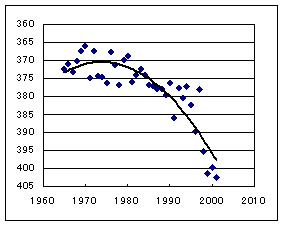 |
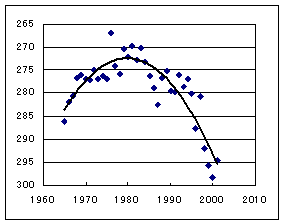 |
| 13- year ♀ | |
| Grasping Power (kg) 握力 | |
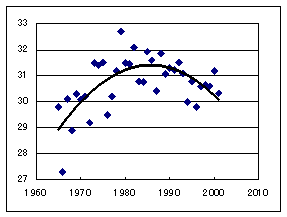 |
 |
| 13- year ♂ | 13- year ♀ |
| Ball throw(m) ボール投げ | |
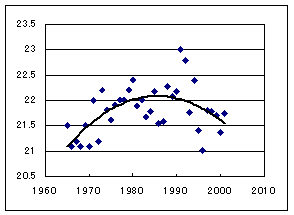 |
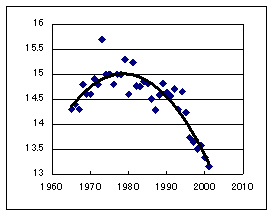 |
| 13- year ♂ | 13- year ♀ |
以下は、星稜女子短期大学(金沢市)の沢野伸浩さんからの依頼で青山貞一が200年5月16日、衆議院第二議員会館第一会議室で開かれました国会議員向け講演でシーア・コルボーンさんにあらかじめ論文概要をお渡しし、質問した内容です。
Declining Physical Strength of Japanese Children
Seiryo Women’s Junior College
Nobuhiro Sawano (sawano@seiryo.ac.jp)
Dear Dr. Colborn,
I am really sorry I have not written for ages. I am very happy if you remember that we discussed the problem of declining children’s physical strength in March, 1999. One or two weeks before I called on you, one of the most famous Japanese journalists Takashi Tachibana had an interview with you. As I told at that time, decline of children’s physical strength is still continuing today. More over, within these two or three years, declining speed seems even accelerated.
When I visited at your office, Dr. Smolen gave me a good suggestion. He said, if we try to make clear the relation between decline of physical strength and environmental factors, we have to compare the spatial distribution of physical strength and levels of environmental contamination. After I returned, I started to prepare GIS (Geographical Information System) for this purpose. Fortunately, Japanese Map Agency began to offer digital map data with reasonable prices, I successfully arrange every “tool” for analyzing children’s data with spatial distribution.
As I also told in your office, each Japanese prefecture holds long-term data of children’s physical strength. Nation-level survey was started in 1964 as “sports test” thus we can analyze the changing in these 40 years. Data are highly reliable because this survey has been conducted under the same criteria and degree of freedom is quite sufficient. One third of total population in the same age takes this survey. Now, I have whole data having been stored by Ishikawa Prefecture, but this prefecture occupies only 1% area of Japan. It is too small to make spatial analysis.
So I have a wish. If you have a chance to talk with Japanese Diet members, please let them know physical strength of Japanese children has been sharply declining in these 20 years and some environmental reasons are suspected. If we try to make clear the relation, we have to collect data throughout our country. Thus, cooperation of Diet members with good sense is indispensable.
Lastly, please take care of yourself. Have a good job and enjoy Japanese way of life for a while.
My best regards,